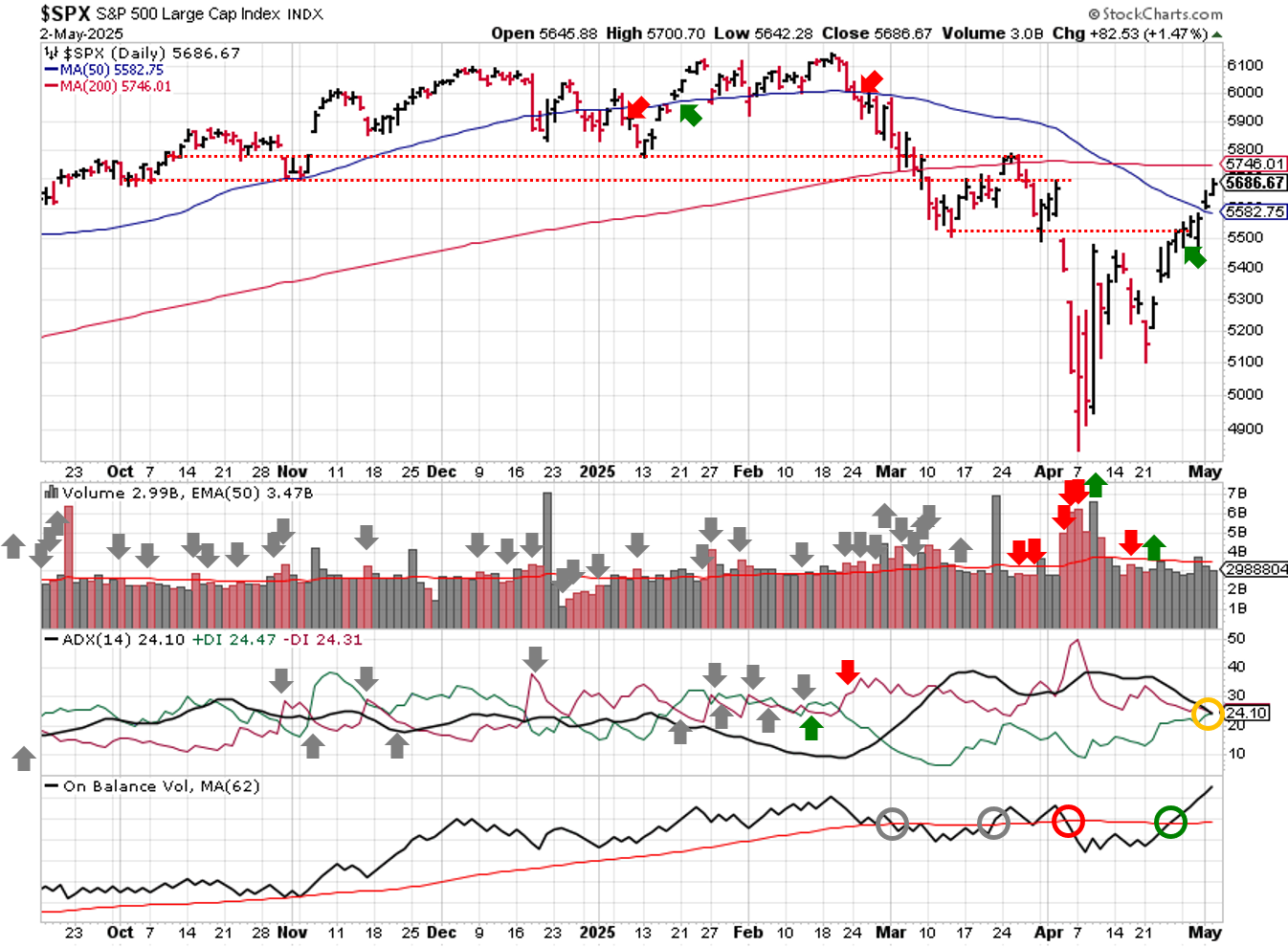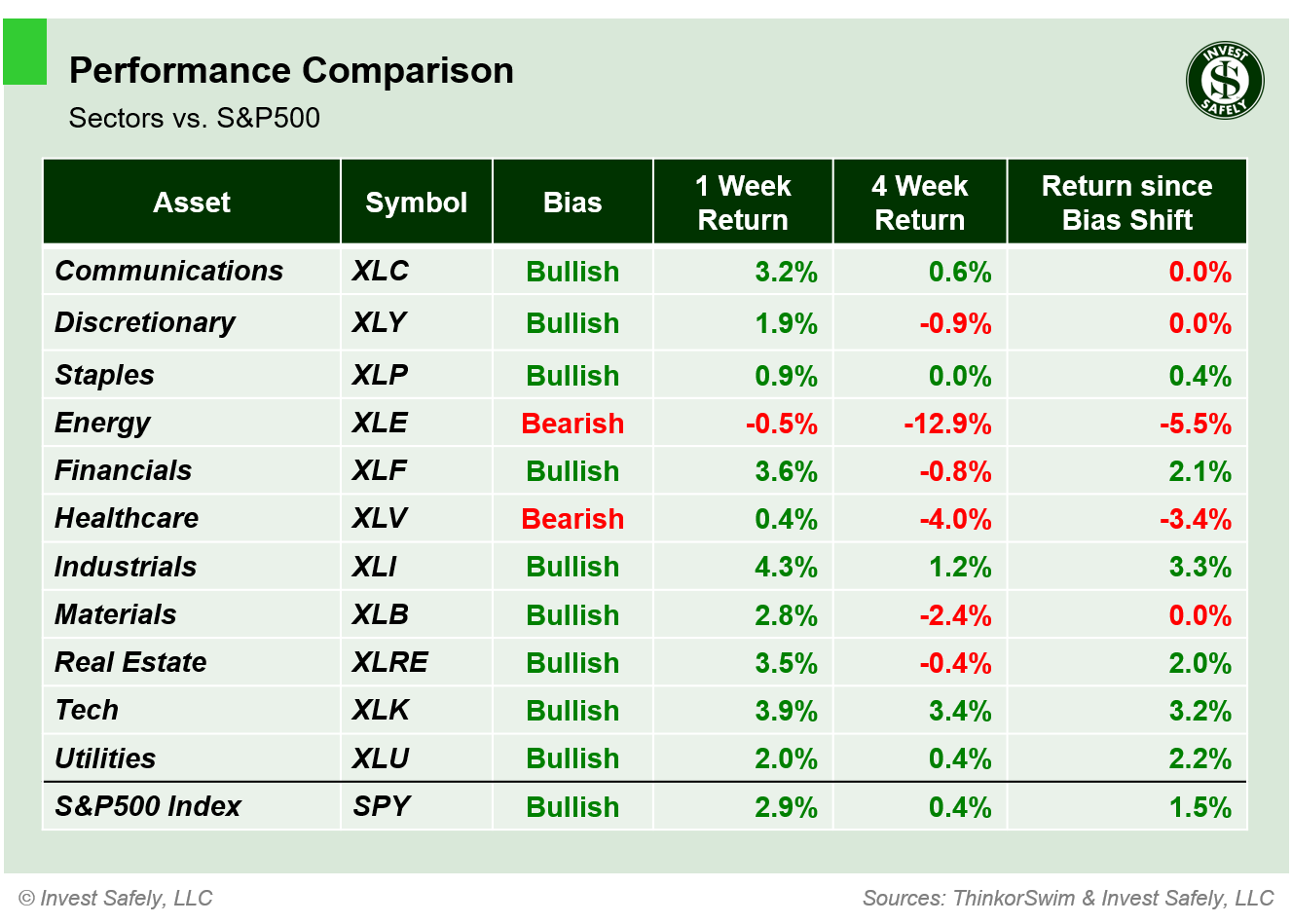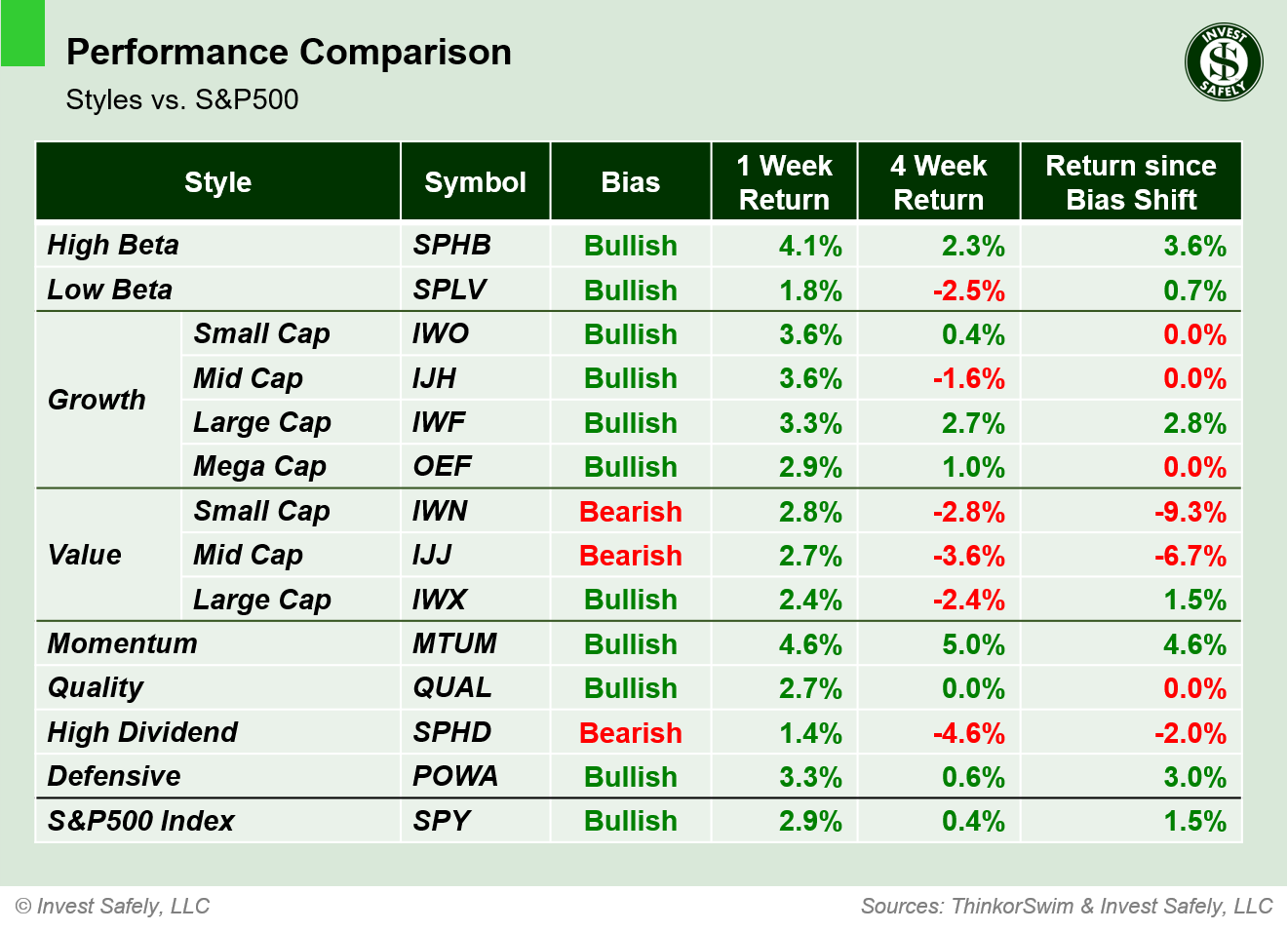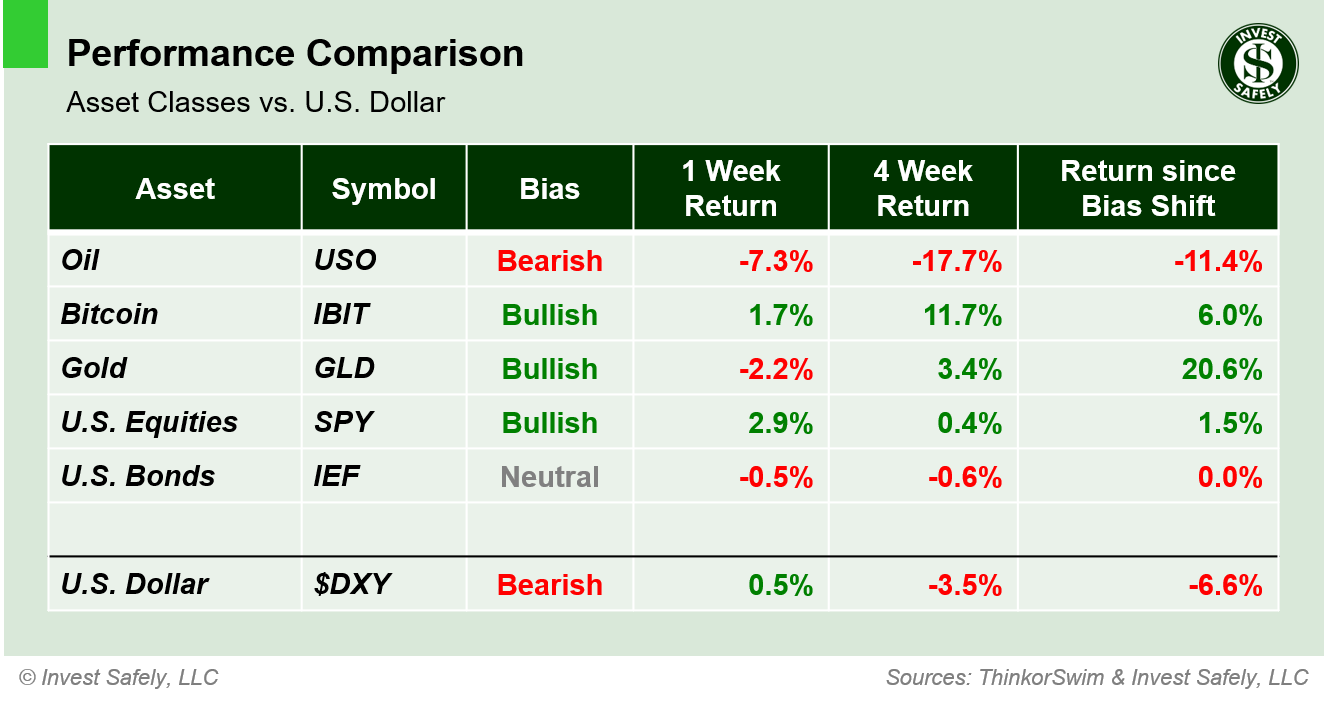Stock Market Outlook
For The Week Of May 4th = Uptrend
INDICATORS
-
ADX Directional Indicators: Neutral
Institutional Activity (Price & Volume): Uptrend
On Balance Volume Indicator: Uptrend
ANALYSIS
The stock market outlook shifted back to an uptrend last Monday, as buying pressure flooded into equities. Along with the market, many sectors also shifted to a bullish bias.
The S&P500 ( $SPX ) rose 2.9% last week. The index sits ~2% above the 50-day moving average and ~1% below the 200-day moving average.
SPX Technical Analysis - May 4 2025
Institutional activity remains in an uptrend; below average trading volume remains a concern. On-Balance volume ( OBV ), which was on the verge of shifted coming into last week, confirmed its signal Monday and moved the overall outlook back to an uptrend. The Direction Indicator ( ADX ) shifted to neutral on Friday.
Industrials ( $XLI ) led the way last week, rising more than 4%. Energy ( $XLE ) was the only sector without a gain, owing to a large drop in oil prices. Most sectors moved back to bullish bias:
- Communications ( $XLC )
- Consumer Discretionary ( $XLY )
- Consumer Staples ( $XLP )
- Financials ( $XLF )
- Industrials ( $XLI )
- Materials ( $XLB )
- Real Estate ( $XLRE )
- Technology ( $XLK )
All style funds ended the week with gains; Momentum ( $MTUM ) was the highest and High Dividend ( $SPHD ) was the lowest. Most styles returned to bullish bias as well, though small and mid-cap value are still working through their recent losses.
No surprise here; U.S. equities ( $SPY ) led the way higher last week. Oil ( $USO ) collapsed on headlines that OPEC+ agreed to boost output in June. Bonds ( $IEF ) continued to waffle, falling back to neutral bias on the stronger-than-expected jobs data.
COMMENTARY
After an impressive stretch of higher closes, a majority of equity sectors and styles show bullish bias now. The break above the 50-day moving average and 5600 was important; now the index needs to deal with the 200-day and the 5800 resistance level.
Actually, any pullback or consolidation would be the ideal time to deploy capital, giving equities time to cool off, since they're currently overbought. Use the watchlists you've been updating and look for stocks breaking out out of consolidation phases and price patterns with higher volume. And if you do deploy capital, keep those losses small if the trade turns against you.
Despite the bullishness of equities, the macroeconomic picture remains murky at best.
April Non-Farm Payrolls (NFP) data was slightly lower than March, but well above expectations despite uncertainty from all the tariff announcements.
PCE continues to be a challenge for tea-leaf readers: March inflation was inline with expectations, but February data was revised significantly higher (Headline up 20 bps from 2.5% to 2.7% and Core up 30 bps from 2.7% to 3%). Given recent trends, it's reasonable to assume March inflation data is higher than reported and will be revised next month.
| PCE (y/y) | Actual | Prior | Expected |
| Headline | +2.3% | +2.7%* | +2.2% |
| Core | +2.6% | +3.0%* | +2.6% |
The advanced Q1 GDP came in at -0.3%, down from +1.6% in 2024 Q1 and below estimates for +0.3%. A 41.3% surge in imports did the most damage, as businesses stockpiled goods in an attempt to mitigate higher costs from tariffs. Consumer spending and federal government expenditures were also lower.
We need another month or two before seeing the full effect of Liberation Day announcements, as inventories, supply chains, and shipping normalize. And that data won't include any adjustments, or lack thereof, to tariff policies that occur in the interim.
Four of the "Magnificent 7" reported better than expected earnings, but guidance was mixed:
- Meta reported higher revenue & earnings, and gave positive guidance
- Microsoft reported higher revenue & earnings, and gave positive guidance
- Apple reported higher revenue & earnings, and gave lukewarm guidance
- Amazon’s reported higher revenue & earnings, and gave weak guidance
This week we get more earnings and a FOMC interest rate decision. The committee likely keeps interest rates unchanged, since inflation and labor data show a "neutral" picture and imports clouded Q1 economic figures.
Best to Your Week!
P.S. If you find this research helpful, please tell a friend.
If you don't, tell an enemy.
Sources: Bloomberg, CNBC, Federal Reserve Bank of St. Louis, Hedgeye, U.S. Bureau of Economic Analysis, U.S. Bureau of Labor Statistics
Share this Post on:

How to Make Money in Stocks: A Winning System in Good Times and Bad.
It's one of my favorites.
I regularly share articles and other news of interest on:
Twitter (@investsafely)
Facebook (@InvestSafely)
LinkedIn (@Invest-Safely)
Instagram (@investsafely)
Invest Safely, LLC is an independent investment research and online financial media company. Use of Invest Safely, LLC and any other products available through invest-safely.com is subject to our Terms of Service and Privacy Policy. Not a recommendation to buy or sell any security.
Charts provided courtesy of stockcharts.com.
For historical Elliott Wave commentary and analysis, go to ELLIOTT WAVE lives on by Tony Caldaro. Current counts can be found at: Pretzel Logic, and 12345ABCDEWXYZ
Once a year, I review the market outlook signals as if they were a mechanical trading system, while pointing out issues and making adjustments. The goal is to give you to give you an example of how to analyze and continuously improve your own systems.
- 2015 Performance - Stock Market Outlook
- 2016 Performance - Stock Market Outlook
- 2017 Performance - Stock Market Outlook
- 2018 Performance - Stock Market Outlook
- 2019 Performance - Stock Market Outlook
- 2020 Performance - Stock Market Outlook
IMPORTANT DISCLOSURE INFORMATION
This material is for general communication and is provided for informational and/or educational purposes only. None of the content should be viewed as a suggestion that you take or refrain from taking any action nor as a recommendation for any specific investment product, strategy, or other such purpose. Certain information contained herein has been obtained from third-party sources believed to be reliable, but we cannot guarantee its accuracy or completeness.
To the extent that a reader has any questions regarding the applicability of any specific issue discussed above to his/her individual situation, he/she is encouraged to consult with the professional advisors of his/her choosing. Invest Safely, LLC is not a law firm, certified public accounting firm, or registered investment advisor and no portion of its content should be construed as legal, accounting, or investment advice.
The material is not to be construed as an offer or a recommendation to buy or sell a security nor is it to be construed as investment advice. Additionally, the material accessible through this website does not constitute a representation that the investments described herein are suitable or appropriate for any person.
Hypothetical Presentations:
Any referenced performance is “as calculated” using the referenced funds and has not been independently verified. This presentation does not discuss, directly or indirectly, the amount of the profits or losses, realized or unrealized, by any reader or contributor, from any specific funds or securities.
The author and/or any reader may have experienced materially different performance based upon various factors during the corresponding time periods. To the extent that any portion of the content reflects hypothetical results that were achieved by means of the retroactive application of a back-tested model, such results have inherent limitations, including:
Model results do not reflect the results of actual trading using assets, but were achieved by means of the retroactive application of the referenced models, certain aspects of which may have been designed with the benefit of hindsight
Back-tested performance may not reflect the impact that any material market or economic factors might have had on the use of a trading model if the model had been used during the period to actually manage assets
Actual investment results during the corresponding time periods may have been materially different from those portrayed in the model
Past performance may not be indicative of future results. Therefore, no one should assume that future performance will be profitable, or equal to any corresponding historical index.
The S&P 500 Composite Total Return Index (the "S&P") is a market capitalization-weighted index of 500 widely held stocks often used as a proxy for the stock market. Standard & Poor's chooses the member companies for the S&P based on market size, liquidity, and industry group representation. Included are the common stocks of industrial, financial, utility, and transportation companies. The S&P is not an index into which an investor can directly invest. The historical S&P performance results (and those of all other indices) are provided exclusively for comparison purposes only, so as to provide general comparative information to assist an individual in determining whether the performance of a specific portfolio or model meets, or continues to meet investment objective(s). The model and indices performance results do not reflect the impact of taxes.
Investing involves risk (even the “safe” kind)! Past performance does not guarantee or indicate future results. Different types of investments involve varying degrees of underlying risk. Therefore, do not assume that future performance of any specific investment or investment strategy be suitable for your portfolio or individual situation, will be profitable, equal any historical performance level(s), or prove successful (including the investments and/or investment strategies describe on this site).






